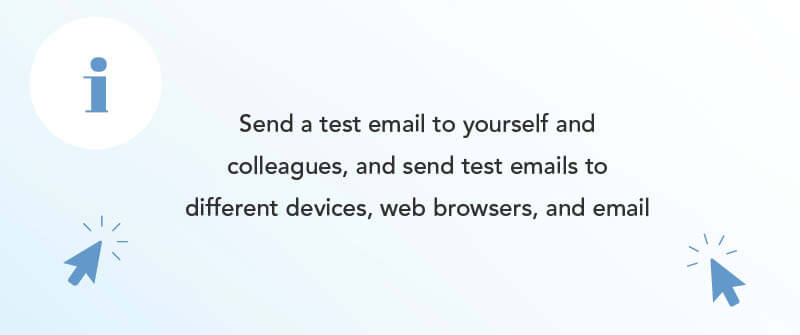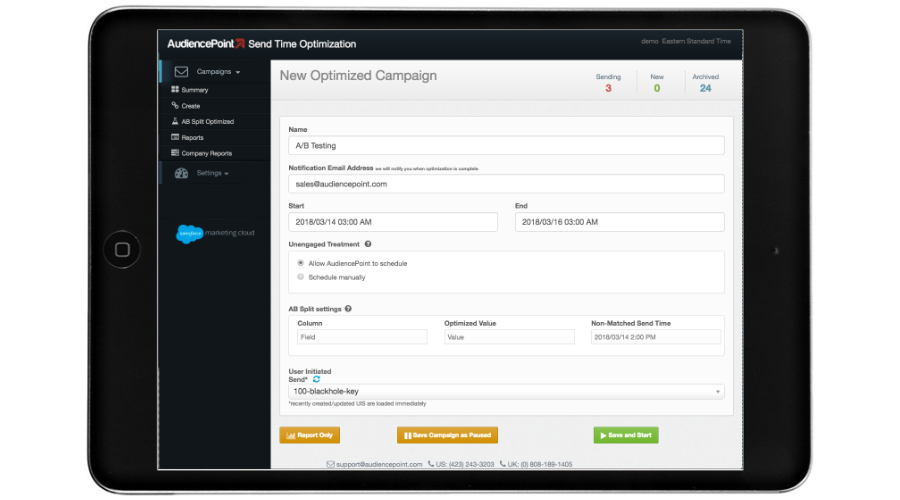AudiencePoint is thrilled to announce our new integration with Klaviyo! AudiencePoint is looking for partners to pilot our...
How Can I Improve My Email Campaign?
For email marketing professionals determined to optimize results, a strategic approach grounded in data, technology, and best practices is critical. Going beyond open rates and clicks, top-performing marketers use a detailed email marketing checklist and powerful tools like AudiencePoint to ensure every campaign lands in inboxes, engages recipients, and delivers ROI. The fundamentals—such as sender reputation and content quality—matter more than ever, but next-generation inbox placement monitoring now allows you to act with confidence and precision.
A Checklist to Improve Your Email Marketing Campaign: Understanding the Difference Between Deliverability and Inbox Placement
Many marketers rely on deliverability metrics without realizing that a “delivered” email may go unseen in the spam folder. Deliverability tracks successful handoff to the recipient’s mail server, while inbox placement reveals if that email actually reaches the inbox. Overlooking this distinction can mean missed opportunities and wasted effort. Knowing when to send marketing emails can also significantly impact inbox placement and engagement, as timing plays a key role in how algorithms prioritize messages. Leveraging AudiencePoint’s groundbreaking analytics ensures you know exactly where your emails are landing, so you can course correct quickly and effectively. Using detailed analytics to track inbox placement and deliverability provides valuable insights for optimizing your email marketing performance.
Importance of a Strong Sender Reputation
A robust sender reputation is non-negotiable for achieving high inbox placement. ISPs reward low complaints, minimal bounces, and strong user engagement with prime inbox real estate. Poor sender practices, conversely, can land even the best-crafted email in the junk folder. Consistent list hygiene, clear opt-ins, transparent opt-outs, and technical authentication (like SPF, DKIM, and DMARC) must be verified before any send. Regularly cleaning your list to remove invalid email addresses and inactive users is essential, as invalid email addresses can increase bounce rates and harm your sender reputation.
Email Marketing Campaign Improvement Checklist
Below is a proven email marketing campaign checklist before sending every campaign—a critical resource to avoid costly mistakes and maximize engagement. This email marketing checklist acts as the ultimate email marketing checklist, serving as a comprehensive safety net for your marketing emails. Adopt and customize this checklist template to fit your organization’s unique goals:
- Pre-Send Technical Checks
- Confirm SPF, DKIM, and DMARC authentication are configured and functional, and verify your authenticated domain is set up.
- Ensure your sender address is recognizable and consistent.
- Check that all the email addresses on your contact list are valid and remove invalid email addresses.
- Test rendering on all major email clients, web browsers, and mobile devices.
- Ensure images have alt text and load properly.
- Check for broken links—broken links lead to a poor user experience and must be fixed before sending.
- Ensure proper UTM tracking on all CTAs for Google Analytics.
- Check that the unsubscribe button is present and that the unsubscribe link works.
- Send a test email to yourself and colleagues, and send test emails to different devices, web browsers, and email clients to check formatting, spam score, and link functionality.
- Use your email marketing software or email marketing platforms to preview and schedule the campaign.

- Audience, Content, and Compliance
- Verify list segmentation and relevancy for the campaign and ensure your contact list is up to date with new subscribers.
- Personalize subject lines and email content to foster a personal connection and create engaging campaigns.
- Double-check compliance with the CAN-SPAM Act, GDPR, and region-specific regulations.
- Review your email content for clarity, personalization, and compliance.
- Provide a visible, easy-to-use unsubscribe link and ensure the unsubscribe link works.
- Check for welcome emails for new subscribers.
- Ensure your contact details are included in the footer.
- Engagement Optimization
- A/B test your email subject line and email subject lines, as well as preview text, for maximum open rates and compelling subject lines.
- Craft a clear and compelling call to action above the fold.
- Optimize send times based on past engagement data.
- Include social media sites share buttons to increase reach.
- Review your content creation process and write email copy that drives engagement and conversion.
- Survey recent campaign performance and key metrics, including conversion rate, click through rate, click through rates, and other email marketing metrics.
- Inbox Placement & Deliverability
- Monitor inbox placement rates using tools like AudiencePoint—not just “sent” and “delivered” statuses.
- Review bounce, complaint, and unsubscribe trends, and check for spam reports before scheduling.
- Suppress unengaged or problematic addresses.
- Avoid spam filters by following best practices and understanding how inbox providers evaluate your emails.
- Final Approval & Sending
- Secure approval from relevant stakeholders and compliance departments.
- Schedule a test send and review actual inbox placement across major ISPs using AudiencePoint.
- Double-check all checklist items have been completed—ensure your email marketing campaign checklist is comprehensive.
- Review your campaign’s success and use insights to inform future campaigns and your next campaign.
- After all checks are complete, press send and monitor results in real time.
By rigorously following this ultimate email marketing checklist, you establish a repeatable process proven to boost inbox placement, protect sender reputation, and maximize ROI. For expert marketers, there’s never been a better time to transition from guesswork to data-driven precision. Invest in powerful monitoring with AudiencePoint, and transform every campaign into a success story.
What Is the 80/20 Rule in Email Marketing?
The 80/20 rule in email marketing, rooted in the Pareto Principle, suggests that approximately 80% of your results come from just 20% of your efforts. When applied to campaigns, this means a small percentage of your messages, audience segments, or content types are likely driving the majority of your opens, clicks, and conversions. Key metrics such as click through rate and conversion rate are essential for evaluating your email marketing efforts, as they provide insight into how effectively your emails engage recipients and drive desired actions. Understanding and strategically optimizing around this principle can significantly improve your email marketing strategy and ROI.
To tap into the 80/20 rule, start with a robust analysis of your campaign data. Identify the types of messages or specific content pieces that consistently generate engagement. These are your top-performing 20%. Focus optimization efforts here: refine subject lines, tweak calls-to-action, and update visuals for these high-impact emails. An effective checklist to improve your email marketing campaign example includes regular reviews to spotlight these winners and allocate more resources or testing to them.
Advancements in inbox placement analytics, such as those pioneered by AudiencePoint, have made it easier than ever to precisely track which segment of your list gets your emails delivered directly to the inbox versus relegated to spam. By leveraging inbox placement data, you can confidently adjust sending strategies, prioritizing those who are most likely to see and engage with your content. Not only does this approach maximize immediate results, but it also safeguards your sender reputation in the long run.
The takeaway for serious email marketing professionals? Don’t spread your optimization efforts thin. Instead, zero in on the data-backed 20% that moves the needle. Tracking key metrics helps you focus your optimization on the most effective parts of your campaign, ensuring that your email marketing efforts are continually refined for better engagement and higher conversion rates. When complemented with AudiencePoint’s advanced monitoring, you’ll be able to continually refine your audience lists, suppress non-engaged or spam-affected addresses, and ensure that your best work lands where it matters most: the primary inboxes of your top recipients.

How Do You Identify the Top-Performing 20% of Your Campaign?
Identifying the top 20% starts with detailed segment analysis. Utilize tools that provide transparent and actionable analytics on opens, clicks, and—increasingly critical—inbox placement rates. Email marketers rely on email marketing metrics to identify top-performing segments and optimize their strategies for better campaign results. AudiencePoint helps you quickly see which recipients engage most and which content types consistently bypass spam filters. Inserting these insights into your email marketing strategy not only amplifies results but also conserves your resources for the audiences and tactics that matter most.
What Are the 5 Ts of Email Marketing?
The 5 Ts of email marketing provide a concise framework that every email marketing professional should master to consistently deliver high-impact campaigns. These essential principles—Tease, Target, Teach, Test, and Track—allow marketers to craft compelling messages, reach the right audience, provide value, optimize campaign effectiveness, and measure results. By incorporating each “T” into your email marketing checklist or using an email checklist template, you ensure that no crucial detail is overlooked and your outreach is always strategic and data-driven.
- Tease: Crafting Engaging Subject Lines
Your subject line acts as the front door to your email and plays a pivotal role in determining open rates. Crafting compelling email subject lines is essential to increase open rates and capture your audience’s attention from the start. The tease factor is about intriguing your audience by piquing curiosity or highlighting a clear benefit. A/B testing different subject lines isn’t optional; it’s necessary for email professionals aiming to break through inbox clutter. Personalization, such as including the recipient’s first name, can significantly boost engagement and drive action, setting the stage for the rest of your content.
- Target: Segmenting Your Audience
Targeting involves sending the right message to the right segment at the right time. Using advanced segmentation ensures that every communication is relevant and impactful. Savvy marketers leverage behavioral and demographic data to custom-tailor content, driving stronger engagement and higher ROI. AudiencePoint enables granular segmentation and can help pinpoint the best time to send an email blast for each segment, giving you a decisive edge in crowded inboxes.
- Teach: Providing Valuable Content
Value is the currency of successful email marketing. Teaching your audience—whether through educational content, insights, or actionable tips—builds trust and keeps your subscribers eagerly anticipating your messages. Engaging campaigns foster a personal connection with your audience, making your emails more memorable and impactful. An effective email marketing checklist includes verifying that every send adds value and aligns with your subscribers’ needs and interests. When you provide consistent value, your audience will reward you with loyalty and higher conversion rates.
- Test: A/B Testing and Delivery Monitoring
Testing shouldn’t stop at subject lines—test everything from email copy to call-to-actions and send times. Testing your call to action is crucial to maximize engagement and drive conversions. A/B and multivariate tests allow you to identify top-performing variants, while monitoring delivery ensures your messages reach user inboxes instead of spam folders. Integrating an Email checklist template ensures you’re routinely optimizing all campaign elements. Solutions like AudiencePoint provide deep insights and automated testing, allowing you to iterate and improve with confidence.
- Track: Analyzing Inbox Placement and Engagement Metrics
Effective tracking goes beyond basic opens and clicks. Modern professionals track inbox placement, bounces, unsubscribes, and other critical engagement metrics for a holistic view of campaign performance. Solutions that offer precise inbox placement monitoring—like AudiencePoint—equip you to identify issues in real time and adjust your strategy for optimal deliverability and engagement. Use your findings to refine your approach, ensuring each campaign surpasses the last.
What Are the 4 Ps of Email Marketing?
The 4 Ps of email marketing—Personalization, Permission, Platform, and Performance—form the cornerstone of a successful email marketing strategy. By prioritizing each of these aspects, marketers can drastically increase their campaign effectiveness, maximize ROI, and drive genuine subscriber engagement. While traditional metrics and tactics paved the way for bulk sending, modern best practices and technology now enable a more targeted, measurable, and impactful approach. Leveraging an advanced tool like AudiencePoint seamlessly amplifies the power of the 4 Ps, enabling a checklist-driven, data-informed strategy that keeps you ahead of competitors.

- Personalization: Customizing Content for Every Subscriber
Gone are the days of generic mass emails. Email marketing strategy now mandates personalization—crafting messages tailored to each subscriber’s interests, behaviors, and demographics. This goes far beyond inserting a first name; personalized content should reflect subscribers’ purchase history, browsing activity, and engagement signals. With AudiencePoint’s advanced analytics, you can segment at a granular level and build truly customized messages for every cohort. Data-driven personalization directly influences engagement, increases inbox placement rates, and forms the foundation of a robust checklist to improve your email marketing campaign.
- Permission: Building and Maintaining Compliant Email Lists
Permission is not just a legal checkbox—it’s a best practice that cultivates long-lasting, high-quality relationships. Only target recipients who have clearly opted into your list and frequently review your opt-in and data privacy practices. Compliance with CAN-SPAM, GDPR, and other regulations is essential, but true permission-based marketing also decreases spam complaints and boosts inbox trust scores. AudiencePoint empowers marketers to easily spot problematic addresses and remove them, ensuring your campaigns reach only receptive, engaged audiences. Make permission a central part of your email marketing checklist for unbeatable deliverability and engagement results.
- Platform: Leveraging the Right Technology for Inbox Monitoring
Choosing the right platform is about more than sending emails—it’s about optimizing where those emails actually land. Inbox placement monitoring is now critical to marketing success. Traditional deliverability metrics were blind to the distinction between the inbox and spam folders. AudiencePoint fills this gap by providing real-time, granular insights into actual inbox placement, not just messages delivered. By integrating AudiencePoint, marketers can see which segments receive emails in the primary inbox, which get sent to spam, and where opportunities exist for rapid correction. This makes it a vital component of email campaign best practices and a top entry on any email checklist template.
- Performance: Measuring Success with New Tools and Best Timing
Performance is about using the latest email marketing strategy tools and best practices to measure true success. The funnel framework—Sent → Delivered → Inboxed → Opened → Clicked—shows that high delivery rates are meaningless if your emails aren’t actually seen. With AudiencePoint, you gain deep visibility into not just opens and clicks but how many emails actually evade the spam folder. Combine these insights with optimal send times, A/B testing, and robust engagement analytics to refine your strategy. By monitoring both the metrics that matter and the signals that define inboxing, you can optimize every aspect of campaign performance.
How Do You Turn the 4 Ps into a Powerful Checklist?
To implement the 4 Ps effectively, use a checklist to improve your email marketing campaign. Each send should include a pre-flight review: Have you personalized at every segmentation point? Do you have explicit permission from every contact? Is your platform delivering real insights into inbox placement? Are you accurately measuring performance with actionable data? AudiencePoint offers automated solutions and expert guidance to turn these best practices into standard operating procedures—giving every send the best chance to succeed.
Conclusion: Why Inbox Placement Matters More Than Ever
Today’s rapidly changing email landscape demands more than just achieving basic email deliverability. While getting into the inbox used to be a black box, new tools have given marketers, for the first time, true visibility into inbox placement. Understanding the difference means knowing that just because your email is delivered does not mean it lands where it counts—your subscriber’s main inbox. This critical distinction elevates your campaigns from being sent to truly being seen—and that’s where success is made or lost.
Modern inbox placement monitoring surpasses outdated seed list or panel approaches by measuring real subscriber behavior across massive, live data pools. This increased accuracy means marketers can proactively identify deliverability issues, spot spam folder placements, and take decisive action to protect reputation before problems snowball. When you consistently monitor inbox placement, you prevent engagement and revenue leaks, ensure your message always lands with your most valuable segments, and safeguard your domain’s future reach.
Relying exclusively on deliverability metrics or old-school methods is simply no longer enough. To truly optimize your email marketing checklist and outperform competitors, prioritizing advanced inbox monitoring is non-negotiable. That’s precisely where AudiencePoint enters as a game-changer. Our unmatched approach draws insights from real subscriber actions—opens, clicks, bounces, and more—to provide the clearest, most actionable view of your true inbox placement. No more guesswork—only data-driven confidence and constant improvement.
Now is the moment to embrace the comprehensive email marketing checklist that includes best-in-class inbox placement monitoring. Don’t settle for deliverability alone—lead your campaigns to measurable, lasting engagement and revenue growth by transforming how you see and solve inbox placement. Contact AudiencePoint and empower your team with powerful email intelligence platform and take back control of your strategy, achieving exceptional results where it matters most: the primary inbox.





